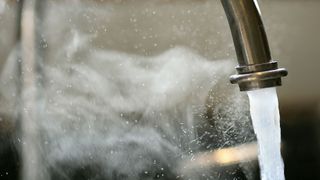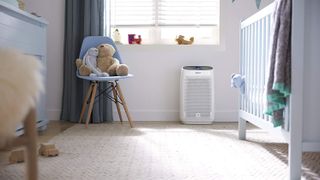The best water softeners are a real essential if you live somewhere with hard water. That’s because without one of these handy appliances, your water is likely to leave a heavy build-up on taps, showers, and you’ll find that shower screen in your bathroom doesn’t ever look sparkling clean anymore. Aside from how it looks, hard water can also cause problems with your water-fed appliances.
In our guide to the best water softeners, you’ll find a choice of salt-free water softeners and salt-based options. Salt-free water softeners don’t require any draining and they work by changing the way the calcium reacts in your water. Salt-based water softeners, however, soften the water by exchanging the hard water ions with salt water ions. Once this has happened, the tank will have extracted a salty brine that requires draining.
But how do you know which is the right water softener for your home? This all depends on how many water outlets you have. For a house with a few bathrooms, you’ll need a water softener powerful enough to take on the job. This power is measured in its GPM (gallons per minute) flow rate.
We’ve compiled multiple independent water softener reviews so that you can find out what’s great and what’s not so great about each model we researched. We’ve also found out what users think of each water softener to help you make an informed decision.
Our promise to you
To help you calculate what type of water softener you need, consider that a faucet uses 3 GPM and a shower uses 5 GPM. To apply this to your home, add up all of the faucets in your home and take your pick from the best water softeners to find a suitable option.
If you’re looking for other home essentials, read our best water heaters guide.
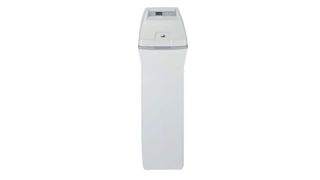
The GE GXSH40V 40,200 Grain Water Softener has a large grain capacity and SmartSoft technology.
What the experts say
Choosing the right water softener for your home can be a struggle, so, we've found some expert advice from PremierWater Technologies Minnesota.
“The first thing you should determine is the actual size of softener you need. A water softener that is too small will frequently run out of soft water, reduce water pressure, require more service, and have a reduced service life.
Oddly enough, a water softener that is too big can suffer from a different set of problems.
Water softeners are full of small plastic beads called ion exchange resin. These resin beads remove hard water minerals by pulling them out of the water – much like a magnet.
A water softener’s capacity is based on the amount of resin inside the unit. 1 cubic foot of resin can remove 32,310 grains of hard water minerals (calcium, magnesium, iron, and manganese)."
Best water softener overall

The GE GXSH40V 40,200 Grain Water Softener has a grain capacity of up to 40, 200, and has a flow service rate of 9.5. This makes the GE GXSH40V 40,200 Grain Water Softener an ideal choice for households with four people. If you have more members or lots of bathrooms in your home, you will be better off with a more powerful water softener.
Users gave the GE GXSH40V 40,200 Grain Water Softener an average rating of 4.4 out of five stars on Home Depot’s website. Positive reviews mentioned how easy to install this water softener is and that it’s ‘great value’. Some reviews, however, reported problems with the softener arriving faulty.
This salt-based machine has easy-to-use electronic controls but it also features SmartSoft technology which aims to take the guesswork out of making sure you have enough soft water for your home. This machine will get to know your household's water use and adapt accordingly.
As this is a salt-based water softener, you will need to refill the salt tank, but an empty indicator on the machine will let you know when to do this.
Another clever feature that we like is the functionality to choose how soft you want your water to be, as well as the ability to schedule the regeneration cycle at a time to suit you.
There's a one-year warranty on this entire appliance for added peace of mind and the water softener offers good value for money.
- Read the full GE GXSH40V 40,200 Grain Water Softener review
Best large capacity
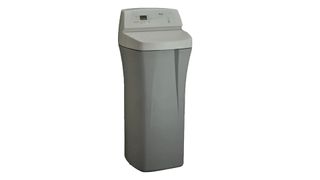
The Whirlpool WHES44 44,000 Grain Capacity Water Softener can remove up to 140 GPG of hardness from your water and has a large grain capacity, making it suitable for family homes.
The Whirlpool WHES44 44,000 Grain Capacity Water Softener has an average rating of four out of five stars on Lowe’s website. Users claim that this water softener is easy to install and that it’s compact. One user claims they’ve had ‘5 years of flawless operation’. Some users, however, state that the salt erodes this tank quickly and there’s ‘no water usage data available.’
The water softener’s control panel lets you choose the regeneration start time and there’s an in-built sensor that triggers the regeneration cycle. What’s more, the Whirlpool WHES44 Water Softener has a one-piece cabinet design, this means it doesn’t take up a huge amount of space as the resin tank is housed inside the salt reservoir.
The Whirlpool water softener offers a flow rate of 9 GPM, placing it just behind our top pick from GE. As with the GE model, you'll need to power this water softener with electricity and it does require draining due to it being salt-based.
Regeneration uses around 43 gallons of water to cleanse the media and the Whirlpool WHES44 Water Softener also has an iron removal setting which activates and an extra backwash cycle to remove excess iron buildup.
- Read the full Whirlpool WHES44 44,000 Grain review
Best for small homes
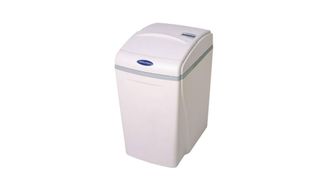
The WaterBoss 700 22,000 Grain Capacity Water Softener uses salt to treat hard water. This machine can take on water with a hardness of 70 GPG and it can hold up to 22,000 grains of hardness before it needs to regenerate.
The WaterBoss 700 22,000 Grain Capacity Water Softener scored an average of 4.2 out of five stars on Home Depot’s website. Users commented on how easy to install this unit was, and that it was ‘incredibly reasonably priced’. Some users criticize the sturdiness of the cabinet.
The WaterBoss water softener is one of the smallest capacity units in our round up, however, it has one of the highest flow rates at 16 GPM, making it a powerful choice considering its size.
What’s more, this water softener also has a self-cleaning sediment filter that traps sediment before it gets into your plumbing and causes further issues. The
WaterBoss has a regeneration cycle that takes about 19 minutes, which is fairly quick for a water softener. As with the models we've included in our guide, the WaterBoss water softener lets you schedule when you want the regeneration cycle to start, and there's also a self-cleaning cycle.
Best saltless water softener
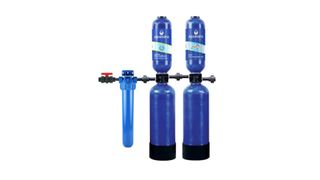
The Aquasana 1,000,000 Gallon Rhino water softener is a saltless option that is suitable for homes with up to 3.5 bathrooms. Because this water softener doesn’t require any salt, it also won’t need to regenerate in order to empty out all of the salty brine.
The Aquasana 1,000,000 Gallon Rhino water softener has an average user rating of 3.8 out of five stars on Amazon. Some users said this water softener is ‘worth the money’ and installation was easy. Others do mention that this water softener will decrease your water pressure and many mention issues with customer service and damaged boxes.
Instead of using salt, the Aquasana 1,000,000 Gallon Rhino water softener uses filters to get rid of excess calcium, bacteria, and unwanted particles from your water. What this means, is that your water won’t be any softer as such, but instead, it won’t contain the minerals that clog up your pipes and cause issues.
What we also liked about the Aquasana 1,000,000 Gallon Rhino water softener is that you can add optional filters that can remove bacteria and kill viruses in the water. This requires a UV filter, which will need an electrical hookup.
The flow rate of this water softener isn’t the most powerful at 7GPM, however, and you will pay a premium compared to salt-based water softeners but you should expect this unit to last a little longer.
For added peace of mind, the Aquasana has a ten-year warranty, but this doesn't cover the filter cartridges.
- Read the full Aquasana 1,000,000 Gallon Rhino review
Best water softener for the whole house
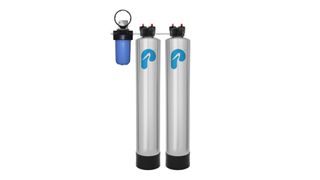
The Pelican THD-PSE1800 Water Softener is a saltless model which can treat hard water across an entire home. Pelican offers a variety of sizes for this water heater, and its biggest has a flow rate of 15 GPM and is suitable for homes with up to six bathrooms.
The Pelican THD-PSE1800 Water Softener scored an average of 4.7 out of five stars on Home Depot’s website. One user explains that this unit is a great alternative to an electric model, they added ‘it’s completely self attending - no electricity, no chemicals, and no maintenance other than changing the sediment filter.’ Some users explained that they were ‘disappointed’ that this unit didn’t solve their water hardness problems.
The smaller option of this water softener has a flow rate of 10 GPM and has been designed to tackle hard water in homes with up to three bathrooms.
You will have to maintain this water softener in order to get the most out of it. For example, the prefilter media and other parts will need replacing around twice a year if you use this unit regularly.
This water softener also has a carbon filtration media that will need to be replaced every five years - this is a more complex job where you need to disconnect the filter tank for 48 hours before you can use the water softener again.
As with other saltless water softeners, you’ll also pay more than you would typically for a salt-based water softener, however, typically you should expect your water softener to last a bit longer too.
- Read the full Pelican THD-PSE1800 Water Softener review
How much do water softeners cost?
Water softeners vary in cost depending on which type you go for. Typically, a water softener that uses salt will be available for around $350-$500 and they shouldn’t require too much maintenance. You will need to factor in, however, that salt-based water softeners require electricity to function so there will be a running cost.
Saltless water softeners don’t need an electrical hookup, however, you’ll pay more initially for these units. You can expect to pay anywhere between $1,000 to $3,000 for a saltless water softener and you will need to replace the filters around twice a year too.
How do water softeners work?
Traditionally, water softeners have replaced the minerals in hard water with sodium using a process called ion exchange. There are two tanks inside this type of water softener. One holds little polystyrene beads, sometimes referred to as resin beads or zeolite, while the other holds salt and a liquid brine. Water flows through the resin tank, and the positively charged molecules in the water are drawn to the negatively charged resin beads. The minerals attach themselves to the beads and the water takes on sodium ions.
The result is water that contains salt rather than minerals. Water softened with salt does not leave scale deposits, so your pipes and appliances are better off. It has a kind of "slick" feeling, and soaps or detergents produce far more bubbles in this water than in hard water. People with dry skin generally like salt-softened water because the minerals that dry out their skin are not present. Water treated this way also does a good job cleaning clothes and other items.
There are some drawbacks to water softeners that use salt, however. The regeneration cycle uses up some electricity, you must have a drain for the wastewater, and you need to buy salt and replace it periodically. This softening process adds salt to the water, which could be troublesome if someone in your household needs to adhere to a low-sodium diet. Some individuals also find that water softened with sodium can be detrimental to the kinds of houseplants they grow. In addition, some people dislike the slippery feeling of water that has been softened this way.
With plenty of use, the resin beads in a salt-using water softener eventually become filled with minerals, and they need to be adjusted through a regeneration process. During this process, the household water temporarily stops running through the water softener. Many top-quality water softeners do this automatically at hours of low water use, typically during the night. When the regeneration process is underway, the fluids in the brine tank flow into the resin tank and sodium clings to the resin beads. This replaces the minerals, which flush out of the system through a drain.
Why do you have to add salt to some water softeners?
Not all water softeners require salt, but those that do use the salt as a softening agent. The salt itself doesn’t soften the water, but it draws the hard ions like iron, calcium and magnesium from your water as it passes through the salt.
If your water softener requires the use of salt, it should have a separate brine tank. You’ll need to fill the brine tank with enough salt that its level it at least three or four inches higher than the level of the water passing through it. This is will easy to see, so don’t worry about not being able to tell when you’ve filled it high enough.
Don’t use regular table salt in your water softener, however. This is because table salt is too fine and will dissolve quickly in the brine tank, which can decrease the effectiveness of the water softener or cause damage to the unit. Instead, look for salt designed specifically for your tank. This salt comes in the form of large pellets so it doesn’t dissolve quickly. Experts also suggest checking your salt level in the brine tank at least once a month to ensure it is at the proper levels.
Should you use salt or potassium chloride in your water softener?
In a traditional water softener, salt replaces unwanted minerals. However, if you are trying to reduce your sodium intake, it isn't a good idea to add salt to your water. Also, lots of municipalities have banned water softeners because the salt they use eventually ends up downstream and can be hard on freshwater rivers and streams.
Even if your city and state allow for salt using water softeners, you may want to find a more environmentally friendly option. Potassium chloride is one such alternative. You use it the same way you would salt in the same type of water softener. Potassium chloride pellets might be a little harder to find and a bit more expensive than salt, but they're better for the environment.
Still, potassium chloride isn't a solution for all environmental concerns related to water softeners. Potassium chloride is found in potash fertilizer, so it is presumed to be more environmentally friendly than salt, which is known to damage crops. But generally, water softener bans, when and where they are in place, apply whether you use salt or potassium chloride.
Water softener glossary
Flow rate (GPM): This is the measurement given to how much water flows in gallons per minute. For water softeners, the rate in which the water is softened is called the flow rate.
Resin beads: These are the little round beads inside the water softener, they are used to make the ion exchange happen and to soften the water.
Salt-free water softener: A water softener that doesn't use salt to make the water softer. This type of water softener instead works by taking the harmful minerals out of the water so they don't cause the same issues associated with hard water.
Salt-based water softener: This type of softener creates a chemical reaction to soften water. It requires salt and releases a brine that needs draining.
Grains per gallon (GPG): Grains per gallon is a measurement to identify water hardness. The higher the capacity or grains per gallon, the more water hardness a softener can remove before it needs to regenerate.
Regenerate: This is the name given to the process where a water softener needs to drain out all of the build-up in things like calcium that it has removed from the water.

